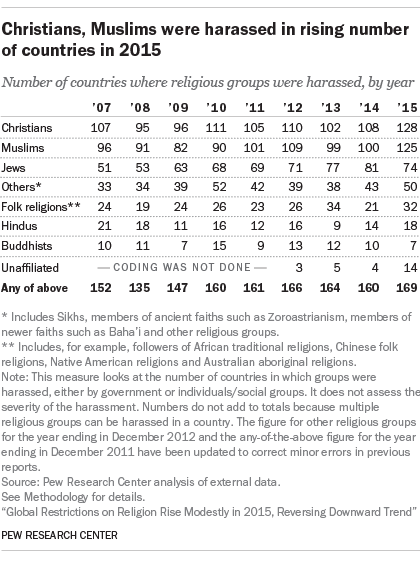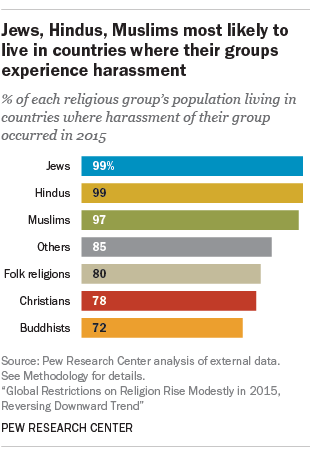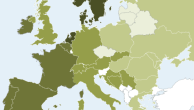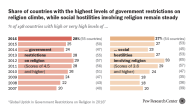In addition to looking at government restrictions on religion and social hostilities involving religion separately, this analysis also combines the two broad types of religious restrictions when examining the harassment or intimidation of specific religious groups. Whether perpetrated by governments or social groups, specific religious groups were harassed in 169 countries in 2015, up from 160 in 2014.23

Harassment of members of specific religious groups takes many forms, including physical assaults, arrests and detentions, desecration of holy sites, and discrimination against religious groups in employment, education and housing. Harassment and intimidation also include things such as verbal assaults on members of one religious group by other groups or individuals.
Christians and Muslims were harassed in the most countries in 2015, continuing a trend from previous years. The number of countries where they were harassed grew significantly for both groups, from 108 to 128 for Christians and from 100 to 125 for Muslims.
Jews faced harassment in 74 countries in 2015, down from 81 countries in 2014. Still, Jews – who make up just 0.2% of the world’s population – face harassment in a notably large number of countries.
Hindus were harassed in 18 countries in 2015, up from 14 in 2014. In contrast, the number of countries where Buddhists were harassed fell from 10 in 2014 to seven in 2015.
Religiously unaffiliated people – including atheists, agnostics and those who do not identify with any religion – were harassed in 14 countries in 2015, up from four the previous year. In Saudi Arabia, for example, atheists were targeted by government authorities and courts. At least two individuals accused of atheism were sentenced to death in 2015: one man in February for renouncing Islam and desecrating a Quran, and Ashraf Fayadh, a Palestinian poet, in November for apostasy.24
Government versus social harassment of groups
Members of some religious groups face harassment from governments more often than social groups, or vice versa. Jews continue to be harassed by individuals and social groups in many more countries than by governments, although the number of countries where individuals or social groups harassed Jews decreased (from 80 in 2014 to 67 in 2015) while the number of countries where governments harassed Jews increased (from 31 to 43). Jews in Europe, for instance, continued to have issues with property restitution. In Moldova, a government agency attempted to take control of the ruins of a synagogue and yeshiva that had been purchased by the Jewish community in 2010. The government’s claim on the property was rejected by a district court at the end of the year.25 And, in Poland, there remained a number of unresolved property restitution cases involving buildings on land that previously contained Jewish cemeteries destroyed in the World War II era.26
Those belonging to world religions other than the groups analyzed in the report – including Sikhs, Zoroastrians, Scientologists, Baha’i and Rastafarians – were harassed by governments in 44 countries in 2015. For example, Egypt continued to ban Baha’i institutions and practices, refusing to recognize the faith.27 And in Panama, Rastafarians were required to remove their head coverings when applying for identification or passports.28 By comparison, social groups were found to have harassed members of this “other religions” category in far fewer countries (18).
There was a large increase in the number of countries where governments harassed Muslims in 2015, from 80 in 2014 to 106 in 2015. The governments of 32 countries in Europe harassed Muslims in 2015 – up from 27 in 2014. Christians also were harassed by governments in more countries, up from 79 to 97. They were targeted by the highest number of governments in the Asia-Pacific region, where 33 countries harassed Christians in 2015.

How size and location of religious groups affects data on harassment

The size and distribution of religious groups provides important context when analyzing the number of countries where they are harassed. Some groups simply have sizable populations in more countries than others, resulting in the potential for harassment in more places. On the other hand, some groups are heavily concentrated in just a few countries, which can lower the number of countries where they are harassed but potentially increase the share of that group’s adherents who live in places where harassment occurs.
For example, Hindus were harassed in just 18 countries, fewer than some other groups. But the vast majority of the world’s Hindus (95%) live in India, where harassment of Hindus by both government and social groups was reported in 2015. Members of the lowest Hindu castes, also known as Dalits, often faced obstacles to basic government institutions and services such as education and health care. The United Nations also reported systematic abuse of Dalits by individuals, and many of the perpetrators of these crimes were not prosecuted by the government.29 Coupled with harassment of Hindus in several other countries with considerable Hindu populations, including Nepal, Bangladesh, Pakistan and Sri Lanka, this meant that 1 billion Hindus, or 99% of the world’s Hindus, lived in countries where Hindus were harassed in 2015.
Christians and Muslims are the largest religious groups in the world – and some of the most geographically dispersed. This helps account for why members of these groups are harassed in such a large number of countries. But Christians are even more widely dispersed than Muslims, which means that harassment of Muslims in certain countries impacts a comparatively larger share of the global Muslim population. As a result, even though Muslims and Christians were harassed in a comparable number of countries (125 and 128, respectively), a larger percentage of Muslims than Christians (97% vs. 78%) live in countries where members of their religion were harassed by governments or social groups in 2015.
The widespread harassment of Jews is notable because about eight-in-ten of the world’s Jews live in just two countries – the United States and Israel – but Jews continue to be harassed in a relatively large number of nations (74 in 2015). Not only do nearly all of the world’s Jews live in countries where harassment of Jews took place in 2015 (99%), but Jews were harassed in many countries around the world where there is just a small Jewish presence.
This is not to suggest that all members of these religious populations were harassed because they lived in countries where incidents may have occurred. Indeed, there are often important regional differences in harassment, especially in large countries such as India, and most people living in these countries probably did not experience harassment directly. But this analysis does demonstrate how geographic distribution – or lack thereof – may intensify the impact of harassment for certain groups.




